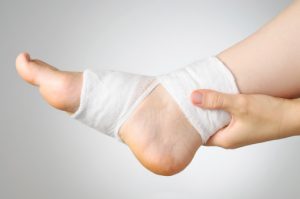 In many countries around the world, cellulitis is on the rise, and experts know that cellulitis risk from staph bacterial infection increases with obesity, as well as a weak immune system.
In many countries around the world, cellulitis is on the rise, and experts know that cellulitis risk from staph bacterial infection increases with obesity, as well as a weak immune system.
Cellulitis is a common bacterial infection of the skin with the potential to have serious consequences. It impacts the surface of the skin and the soft tissues underneath. It can happen if bacteria enters a break in the skin and spreads.
Advertisement
Skin becomes tender and painful with a staph bacterial infection and can become more serious if the infection spreads to the lymph nodes and bloodstream.
Obesity, weak immune system and other risk factors of cellulitis
 Statistical research shows that obesity and a weak immune system are both big risk factors of cellulitis. When it comes to obesity, there tends to be more swelling in the legs, which can increase the chances of cellulitis. It can be difficult for those who are obese to fight off infection because often times they have other health problems, such as diabetes. If a person with diabetes does not have their condition under control, they could have immune issues as well. A weak immune system just adds another risk for obese diabetics.
Statistical research shows that obesity and a weak immune system are both big risk factors of cellulitis. When it comes to obesity, there tends to be more swelling in the legs, which can increase the chances of cellulitis. It can be difficult for those who are obese to fight off infection because often times they have other health problems, such as diabetes. If a person with diabetes does not have their condition under control, they could have immune issues as well. A weak immune system just adds another risk for obese diabetics.
People with a weak immune system, such as elderly people, people undergoing cancer treatments and anyone fighting AIDS/HIV are examples of those who would be at a higher risk of getting cellulitis.
Staphylococcus aureus (staph infection) and other causes of cellulitis
Cellulitis causes can be broken down into two infection categories: group A streptococcal infection, which is the familiar strep throat bacteria, and staphylococcal infection, often referred to as staph infections. Staphylococcus bacteria are known to cause a wide array of infections, ranging from minor skin infections such as boils, to serious infections of the lungs, heart and blood.
Cellulitis can also be caused by a fungal infection; however, this is rare. For instance, it can happen to people who are in the final stages of HIV and are no longer responding to treatment.
When the surface of our skin is damaged in any way, it creates an entry point for bacteria (if we come in contact with it). This allows the bacteria to attack the skin and tissue underneath. The break in the skin does not have to be large; it may be so small that it is not even really noticeable.
A break in the skin can be caused by any of the following:
- Burn
- Insect bite
- Animal bite
- Puncture wound
- Leg ulcer
- Skin conditions (eczema or athlete’s foot)
Symptoms of cellulitis
It is common for cellulitis to attack one of your legs, but cellulitis symptoms can also occur in any part of your body. Generally affected skin becomes hot, red, swollen and tender. Cellulitis symptoms can also include feelings that are similar to the flu, such as nausea, shivering and the chills. People who develop cellulitis may also notice blisters on their skin.
If an area of your skin suddenly turns red, hot and painful, you should seek medical attention.
There are some cellulitis symptoms that could suggest that the staph infection has spread to other parts of the body, such as the blood. If you or someone you know develops any of the symptoms listed below, a visit to the hospital emergency room is wise.
Complications of cellulitis
Complications can arise with cellulitis. The most common are blood poisoning, abscesses, necrotizing fasciitis and meningitis.
If the bacteria are able to enter the blood stream, it can lead to blood poisoning. Aside from a high temperature, dizziness and mental confusion, a person who experiences blood poisoning may also develop a rapid heartbeat, diarrhea, reduced urine flow or even lose consciousness.
In some situations, cellulitis can lead to the formation of an abscess near the infection site. An abscess is a swollen, pus-filled lump under the surface of the skin. It occurs due to buildup of the bacteria and dead white blood cells.
When a cellulitis patient experiences severe pain, fever, diarrhea, vomiting and unconsciousness, it could be a complication called necrotizing fasciitis. This is a bacterial infection of the deep layer of the skin that causes gangrene. Gangrene means the affected tissue dies.
One other complication is facial cellulitis, which is a form of cellulitis that develops on the face. It is not very common, but when it goes untreated in children it can lead to meningitis, a serious brain infection.
Treatment and prevention of cellulitis
 Cellulitis treatment often includes a round of antibiotics. The drug attacks the cell wall of the bacteria. Without this wall, the bacteria struggle to survive in the human body. In most cases, within a few days of taking antibiotics, symptoms of cellulitis improve.
Cellulitis treatment often includes a round of antibiotics. The drug attacks the cell wall of the bacteria. Without this wall, the bacteria struggle to survive in the human body. In most cases, within a few days of taking antibiotics, symptoms of cellulitis improve.
People who do not respond to the antibiotic treatment or who have underlying health conditions and risk factors may have to be hospitalized for observation.
There are also those who try a cellulitis home remedy along with antibiotics to ease their discomfort. Many who suffer from cellulitis have found the following helpful…
- Tea tree oil – strong antibacterial, antifungal and anti-inflammatory properties. Dab it on the infection site, leave it for a few hours and wash it off.
- Coconut oil – contains medium-chain fatty acids, which fight bacteria. Wipe it on affected area, leave it for several hours and wash it off.
- Garlic – it is a natural antibiotic due to its active compound allicin. Consume three to four crushed cloves daily.
- Echinacea – strengthens the immune system. This herb can be taken internally or be applied topically on the skin in the form of gel or cream to treat skin irritation and inflammation.
These are just a few examples of the cellulitis home remedies that are available. A natural health professional can provide you with more suggestions if a cellulitis home remedy approach appeals to you.
When it comes to cellulitis prevention, there are a few steps people can take. It is important to wash any wounds daily with soap and water. Do this gently so you don’t cause irritation. Follow up with a protective, antibiotic ointment such as Neosporin or Polysporin. It may be wise to cover the wound with a bandage and keep it dry. Watch closely for any signs of infection.
People with diabetes should take special steps to prevent cellulitis from occurring, including inspecting their feet daily. They need to catch signs of infection early. They should also moisturize their skin regularly to prevent cracking. Additionally, when they trim fingernails and toenails, they need to take care not to injure the surrounding skin. Wearing protective footwear and gloves is also a good idea.
While there is no cure for cellulitis, as you can tell there is a way to lower your risk through careful observation. It is also important to note that cellulitis may not be contagious; however, athlete’s foot for example is – so at the first signs of the condition, you should start to treat it so that it doesn’t spread to others, compromising their skin and putting them at risk for a bacterial infection.
Related Reading:
MRSA staph infections could be effectively treated with antimicrobials
MRSA staph infections could be effectively treated with antimicrobials. Methicillin-resistant Staphylococcus aureus (MRSA) infection is caused by a staph bacteria that has become resistant to many antibiotics commonly used to treat staph infections. Continue reading…
Advertisement
Fight bacterial infections naturally with these foods and herbs
Strep throat, tuberculosis, urinary tract infections (UTI) – when your immune system isn’t in top shape, you’re more prone to bacterial infections like these. For people with chronic illness with compromised immunity or for seniors, where aging alone means immunity isn’t as strong as it once was, these infections take hold more easily. Continue reading…
Sources:
http://www.mayoclinic.org/diseases-conditions/cellulitis/basics/definition
http://www.webmd.com/skin-problems-and-treatments/guide/cellulitis
http://www.medicalnewstoday.com/articles
http://www.nhs.uk/Conditions/Cellulitis/Pages/Causes
http://wwwnc.cdc.gov/eid/article
http://www.emedicinehealth.com/cellulitis
http://www.nhs.uk/Conditions/Cellulitis/Pages/Symptoms
http://www.healthline.com/health/cellulitis#Treatment
http://www.mayoclinic.org/diseases-conditions/cellulitis/basics/prevention
http://www.top10homeremedies.com/home-remedies/home-remedies-cellulitis
http://www.livescience.com/44201-how-do-antibiotics-work

